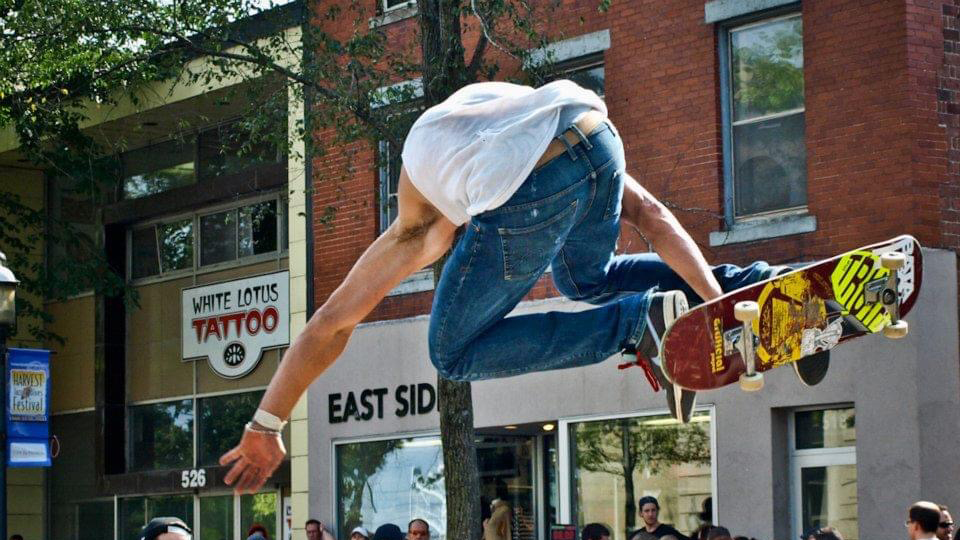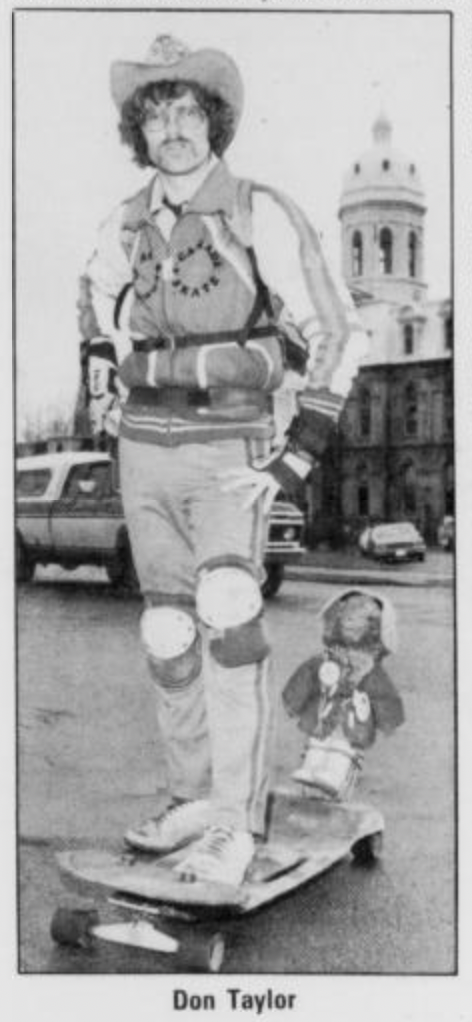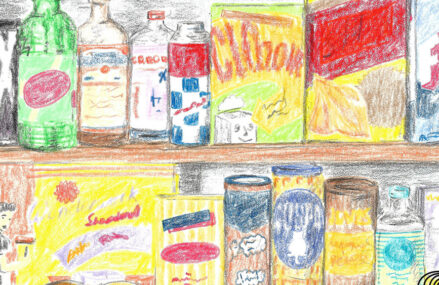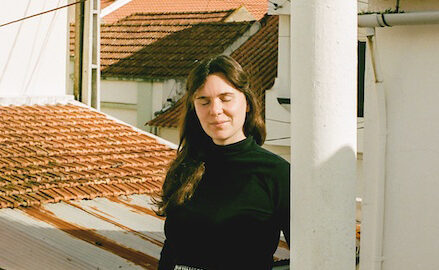To mark the one year anniversary of the city’s $1.4 million all wheel sports plaza, we take a look at the early history of skateboarding in Fredericton to show how skateboarding grew from a passing fad to becoming an accepted sport in the province’s capital city.

Matt Carter
It’s still hard to believe there is now a real skatepark in Fredericton. The Garrison Skatepark was completed a year ago. And it is always busy. On an average summer Saturday the park is filled with people of all ages riding skateboards, scooters and bikes. And there are spectators. Always spectators, snapping photos or shooting video. Sometimes there’s even a band playing. There’s a strong possibility the Garrison Skatepark sees more use on a single day in the summer than every outdoor tennis court in the city combined. The place is alive with energy. And it should be. This energy has been building for more than 40 years.
The first reference to skateboarding in The Daily Gleaner happened on May 10, 1965 with Skateboards Become New Teen-Age Craze, an article from the Canadian Press that undoubtedly helped establish negative attitudes toward the sport even before the first banana boards ever rolled down any street in the city. Despite having a title that would make most readers expect to learn something about what makes this “new teen-age craze” so popular, the feature instead focused on the “bruises, abrasions, scratches and broken limbs,” that were flooding hospital ERs from Halifax to Victoria, contributing to, as the article states, a 5% increase in hospital visits nationwide. No one who rode a skateboard in 1965 was interviewed for the article. There were however, references to, or quotes from, police officers in Montreal, Ottawa, Halifax, Vancouver, Whitney Township, Cornwall, and Sudbury, Ontario, where Staff Sgt. Archie Stewart was quoted as saying, “The toy is one of the most dangerous pieces of equipment I’ve seen yet for children.” With this kind of publicity it’s easy to see why municipalities might have been hesitant to invest in what was essentially deemed to be a menace to children, “and a few so-called adults.”
It would be almost a decade from the time that article was published to when skateboarding first started to appear in Fredericton with any regularity. During the late 1970s, homemade ramps started popping up in parking lots, on campus and behind local businesses. Photos of skateboarders frequently appeared in the paper, although most depicted the sport being enjoyed elsewhere in cities across the United States and Europe; fluff pieces that inadvertently poked fun at what many believed to be a passing fad like the yo-yo or the hula hoop.
But while the bulk of limited, locally published commentary on the sport took place solely through Letters to the Editor in The Daily Gleaner (The Skateboards – April 5, 1977) and through continued public warnings (Skateboard Warning Issued – July 10, 1978), the sport’s growing popularity could not be denied. In 1978, then reigning Canadian Freestyle Skateboard Champion Steve Ibberson visited the city to give a demonstration and clinic at the Fredericton Exhibition Centre. In nearby Oromocto, the town’s Leisure Services Department was given permission to erect ramps at both Gesner Elementary and Waasis Road Junior High schools for the summer months with the town accepting all liability for their use. That same summer, skateboard races were added to the town’s annual Pioneer Days festivities attracting 33 participants.
“The solution is to try to construct some minor facilities to meet the needs of most of the skateboarders in the city. Skateboarders deserve to right to proper facilities the same as a baseball player or anyone else.”
– Bob Mabie, Fredericton Recreation Director, 1978
You could say skateboarding’s presence in Fredericton was made official in October 1978 when The Daily Gleaner ran a full page feature on the Fredericton Pepsi Skateboard Team (Skateboarding: High Risk Sport Catching On – Oct. 7, 1978). The article included interviews with team members Andy Smith and Jamie Smith who explained how they established a partnership with Maritime Beverages Limited to cover the cost of stickers and team t-shirts, inspired by the California-based Pepsi Skateboard Team which included, among others, soon-to-be legendary skateboarder Stacy Peralta. Both athletes also shared their experiences traveling to compete in Ottawa earlier that year where Jamie and fellow Fredericton skateboarder Ross MacNamara took home second and third placings in a national tournament. A companion article, Drainage Ditch Only Available Facility, ran in the same issue and outlined how local skateboarders were forced to use a paved drainage ditch at Garden Creek School to practice and train for national competitions. In the article, city recreation director Bob Mabie indicated the city’s intention to address the lack of proper skateboarding facilities saying, “The solution is to try to construct some minor facilities to meet the needs of most of the skateboarders in the city,” and he went to say, “skateboarders deserve to right to proper facilities the same as a baseball player or anyone else.”
While Bob Mabie’s show of good faith may not have yielded immediate results, or results of any kind besides highlighting the needs of the local skateboarding community and their desire to practice and train anywhere else but a drainage ditch, the city was slowly starting to accept skateboarding as more than a passing fad. For St. John River Day (what ever happened to St. John River Day?) on June 30, 1979, the city’s community events programming paired local skateboarders with members of the Elm City Wheelchair Sports Club for an afternoon demonstration on a stretch of paved park behind The Playhouse known as Centennial Park. The event received public praise through a Letter to the Editor written by Penny Belyea of Hampton, NB (Skateboard Facilities Needed – July 6, 1979) who attended the demonstration and asked, “How about the city taking interest in this new growing sport and providing skateboarders with permanent facilities?” Remember, this was in 1979.

Unrelated but Interesting: In doing some research for this story, I also learned about Don Taylor, the British Columbia man who skateboarded across the country between 1981-82 to bring attention to the needs of the disablied. His trip was completely self-financed and he didn’t no solicit donations for his cause. In her article for The Daily Gleaner from November 23, 1982, staff writer Louella Billings wrote, “…[Taylor] is not asking for donations. He is asking that people be aware of the needs of the disabled and more importantly, have compassion and understanding towards the needs of those less fortunate.” What a champ, and what a positive image for skateboarding.
“All we’re asking you is to provide us with an alternative.”
– Fredericton skateboarder Nick Oliver, 1988
It would be nearly another ten years before the topic of establishing a permanent skateboarding facility in Fredericton would once again reach council chambers. In his presentation to the city’s Community Services Committee on May 26, 1988, 18 year old Nick Oliver, speaking on behalf of the Urban Skaters Union, highlighted once again the need for a designated area for skateboarders to practice and ride without fear of being ticketed by police. Noting that skateboarding was not allowed in parks, on city streets and sidewalks, and how the owners of most private parking lots who rather not see their spaces used to support skateboarding in any fashion, Oliver laid the group’s needs bare saying, “All we’re asking you is to provide us with an alternative.”
Marc Landry was one of the skateboarders who joined Oliver for that meeting with the city. 13 years old at the time, Landry, now a classroom teacher in New Brunswick, would continue to be involved in city/skateboarder relations for the next 30+ years.
“I remember it rained that day. We skated out front of city hall and then moved to the Carleton Place parking garage that night because there was a roof,” said Landry. “That was my first introduction to the community. We had ramps around town and all the skaters kind of knew each other. Basically, if you had a skateboard and a Tony Hawk haircut you were in. Everyone had something to offer. We were all trying to get something built.”
Oliver’s group submitted a number of suggestions and ideas to the city’s recreation department who submitted a $15,000 funding proposal for the city’s 1989 fiscal year. On Christmas Eve, some details of the city’s 1989 budget were shared in The Gleaner. Among the expenses planned for the year ahead were a new personal computer for the Police Chief ($1400), two new personal computers for processing police reports ($3600), $9400 in photography and fingerprinting supplies and $5000 in new “weapons.” The Recreation Department’s proposal was turned down. Despite another setback, skateboarding in Fredericton continued to grow in popularity.
While the city seemed uninterested in supporting the needs of the fast growing sport, other municipalities around the province were attempting to accommodate skateboarders within their communities. Places like Oromocto, Bathurst and Hartland which all functioned with far less resources than the provincial capital, had all surpassed Fredericton in their efforts to support skateboarders by providing designated areas for skateboarding and incorporating skateboard competitions into their annual events calendars. Oromocto included competitions as part of its Pioneer Days celebrations, and Hartland introduced skateboarding events into its Potato Days festivities.
In the fall of 1994, six years after Oliver made his pitch to the city’s Community Services Committee, New Maryland Mayor David Wiezel expressed his interest in working with the skateboarders in his community. He committed to investing $4000 (the total investment would top $15,000 in the coming year) as part of the new athletic park the village was planning. But in Fredericton, skateboarding was still seen largely as a public nuisance. That same month, the city announced it would be raising fines for violations of the bylaw S-9 from $25 to $50. In spring the following year, just as the outdoor skating season was setting in, Sheldon Geldart, superintendent of the Fredericton Police Force went public with his intent to crack down on skateboarders riding on streets, sidewalks and parks including Centennial Park where many of the city’s skateboarders would gather to ride.
“Over the past 18 months, the [police] force has been attempting to resolve the issue of skateboarders in city parks and on sidewalks, without resorting to prosecution,” said Geldart in an article that ran in The Daily Gleaner on May 27, 1995. “We now feel there is no recourse and will commence enforcement effective May 29.”
“In the 90’s, everything shifted from ramps to flat ground and ledge oriented skateboarding,” said Landry. “TNB (Centennial Park) was ideal. There were these globe monuments that had ledges and there were a couple of green transformer boxes that sat on these nice slabs of cement that were low enough to try something beyond a curb level. They were higher than a curb but lower than a ledge so you could build up to stuff. It was a great spot.”
Geldart’s intentions were met with protest. On Friday June 2, about 50 local skateboarders gathered at Centennial Park and marched to City Hall chanting slogans and carrying signs that read, “Let Us Skate”. Once at City Hall, a few members of the group met with deputy mayor Brenda Sansom who assured the group she would request that council arrange a proper meeting with the skateboard community to address the group’s needs. Speaking with Tim Porter of The Daily Gleaner, 18 year old Ryan Hoben was quoted as saying, “No matter how hard the government tries, it can’t stop people from doing what they love. Our life is skateboarding. I will skateboard whether I get a fine or not.”
Comments by 16 year old Chris Saulnier, who also spoke with Porter, mirrored those Oliver made to the city’s Community Services Committee seven years earlier. “Instead of flat out saying no, I wish they would compromise,” he said.
“They wanted their own space and seemed very pleased we are going to provide that for them.”
– Fredericton Mayor Brad Woodside, 1995
The city did compromise. Just a week later Mayor Brad Woodside met with a group from the community and came up with a plan. “They were very genuine in their request,” said Woodside. “I think council believes there’s a real need there – that we can no longer go out and fine people without giving them an option. They wanted their own space and seemed very pleased we are going to provide that for them. Council really wants a partnership between the skateboarders and the city. Now they’re going to show us that the need was genuine and that they’re going to use this area and look after it.”

The area Woodside was referring to was a section of parking lot behind what was then called Lofood, a former grocery store on the corner of Queen and Westmoreland Streets. The park opened just a few weeks after Woodside met with members of the skate community. However, it lacked the infrastructure local skateboarders were looking for. It was basically a paved area with a few benches and a lump of asphalt packed against a light pole. It was a good quick fix from the city’s perspective but that was about it. After only a few weeks of use, skaters began returning to Centennial Park in numbers.
It’s important to highlight the volume of Letters to the Editor received and printed in the local paper concerning the issue of skateboarding in the city. Coming mostly from parents who took to the forum to share their disapproval of the city’s limited actions in support of their children who were being painted as delinquents simply because of their chosen pastime, their voices undoubtedly played a major role in keeping the city’s feet to the fire. While not every letter printed was sympathetic to the cause, the majority were. In an anonymous letter printed on July 16, 1996, one “Skater’s Mom” spelled out the reality of the situation in no uncertain terms.
“With all due respect to the City of Fredericton, mentioning their skateboarding park should be an embarrassment to them. The skateboarder’s park is a used, old, ratty piece of pavement that they cordoned off for these kids. If I were on City Council or part of the city’s members who put this ‘park’ together, I wouldn’t admit it. As far as an expense for the skateboarder’s park, can the city tell me how much it would cost for a couple of portable ramps? Why not put them in an unused arena for the period these teens would use them over the school summer vacation months? Is it too much of an expense to keep our teens involved in an active pastime?
“Personally, I think our children are worth investing in. They are not asking for a lot in looking for a skateboarder’s park, but the city would like us to think they want the moon! After seeing what New Maryland has invested in skateboarders in their community, I think that our officials would have their heads hung in shame.”
1996 could be seen as the year things started to change, somewhat. Both Fredericton and New Maryland held their first skateboarding competitions, and although skateboarders continued to receive fines for skating on streets and sidewalks, the community of skateboarders in the Greater Fredericton Area, with the support of many parents, had a growing voice in the city. But the conflicts continued. There was the infamous “jocks vs. skaters” brawl that took place downtown near Centennial Park in May 1997 which required about a dozen police officers to break up, and on June 3, 1997 Fredericton resident Myrlyn Parker disrupted a city council meeting yelling, “You don’t even know what the hell is going on”, and admitting he had threatened violence against the skateboarders who keep him up at night while rolling past his Regent Street home. Some downtown businesses continued to complain about the presence of skateboarders outside their buildings, and there was even a scuffle between a pair of skateboarders and an off-duty police officer. Though tensions were rising from all sides, the city, to its credit, continued to show an interest in keeping the conversation going. When the city’s 1998 budget was announced in December of 1997, $20,000 was to be invested in skateboarding facilities.
Over the coming years, ramps were built first at Kimble Road Park and later at Henry Park on the city’s north side. Compared to larger centers, these two facilities were still small in scale, but they represented a major accomplishment to the city and the local skateboarding community as the first major investment after decades of negotiations and altercations. It was a major step.
Another major indicator skateboarding in Fredericton had reached a new level of acceptance was seeing the results of the River City Skateboard Association’s third annual competition included in the sports section of the local paper. This simple move gave some long overdue local credibility to the sport.
“They had to close the park a few weeks ago because it was too busy. To me, that says, ‘OK. How fast can we build another one?’.”
– East Side Shop owner and Fredericton skateboarder Brian Muir
Somewhere around 2013, a group of skateboarders organized and incorporated under the name Fredericton Skateboard Inc. began lobbying the city for a larger facility. More than thirty years after the first requests for support were made to the city, the possibility of a large “all wheel” park was again a topic of discussion. By this time, summer programs in skateboarding and local competitions were a regular occurrence. East Side (Board Supply) had been operating for 15 years, and for the most part, calling skateboarding a public nuisance had fallen out of fashion.
It may have taken nearly a lifetime, but the long game eventually paid off with the creation of the Garrison Skatepark, the $1.4 million all wheel sports facility located downtown, located within eyeshot of city hall. To complement the park, the Fredericton Public Library announced it would be making skateboards and safety equipment available for loan, a move that would have been unheard of even ten years ago.
Brian Muir started skateboarding in Fredericton in the late 80’s and opened his business East Side in 1998.
“Since I started this business about 25 years ago, I’ve been working with the city and it’s been baby steps to finally get a significant investment,” said Muir, speaking with Grid City Magazine in May of 2021. “They had to close the park a few weeks ago because it was too busy [to maintain proper distance under current COVID conditions]. To me, that says, ‘OK. How fast can we build another one?’”
At this point in the story, we’ll hand the timeline off to local filmmaker Jordan Greer. In his film series, Never Say Die, Greer documents the efforts of the local skateboarding community over the past nearly twenty years that eventually resulted in the creation of the Garrison Skatepark. His six-episode series, originally created for Bell Fibe TV1 is now available for streaming on YouTube.




